
Grand Canyon National Park, in collaboration with partners, is conducting a pilot stewardship project at Granite Camp and within the Monument Creek Watershed. This is a very popular area for backcountry and river users, but like many areas within the Colorado River corridor has been adversely impacted by the operations of Glen Canyon Dam, high recreational use, and the introduction of non-native plant species, particularly tamarisk (Tamarix ramosissima). The goals of this pilot project are to rehabilitate the native riparian plant community and wildlife habitat, recover data from and stabilize a threatened prehistoric archeological site, and enrich the overall visitor experience. The work at Granite Camp will be completed in phases. The first phase began with an assessment of current site conditions that included a vegetation inventory, soil sampling, and the installation of temporary groundwater monitoring wells to measure the distance to ground water. The second phase consisted of large scale tamarisk removal throughout designated areas of the camp and the third phase involved planting the site with a variety of native vegetation. Park staff will continue to monitor the site for the next several years. Work crews will be present intermittently at the site through the fall 2013. While all efforts will be made to minimize impacts to visitors, on-site work may still be disruptive and limit opportunities for a wilderness experience. 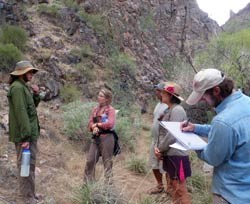
The Big Picture Park staff collaborated with Fred Phillips Consulting to develop a comprehensive rehabilitation design and implementation plan that incorporates lessons learned from similar projects elsewhere along the Colorado River. 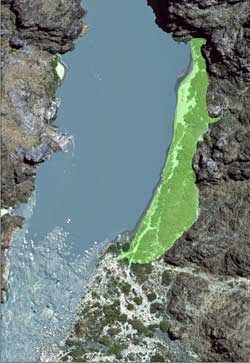
The primary vegetation treatment area begins at the river camp and continues downriver from the boat docking and kitchen areas to the confluence with Monument Creek. Crews conducted selective tamarisk removal at the upstream end of camp (near the groover site) to promote growth of willows and baccharis currently along the river. Every effort was made to maintain the functionality of the camp and improve the overall visitor experience at the site.. 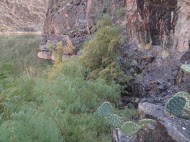
Tamarisk Removal Tamarisk trees were removed using only hand tools. Tree branches were cut back until only a stump of remained. Crews then excabated the stumps by digging down, cutting the stump several inches below the ground surface and treating the cut stumps with herbicide. Minimal amounts of aquatic approved herbicide were applied trees to prevent re-sprouting. The wood and vegetative debris was then disposed of into the river. Native Plant Rehabilitation In January and February, park staff and volunteers collected 118 coyote willow (Salix exigua) poles from Bright Angel Creek, 23 Goodding's willow (Salix gooddingii) from along the Colorado River and 24 total cottonwoods (Populus fremontii) from both Nankoweap and Kwagunt Canyons. The dormant poles were cut to lengths of 7 feet and soaked in the creek or river 4-14 days. Soaking the poles allows them to fill with water and once they are planted in the sand, they can begin to send out roots. Working with volunteers and a crew from Canyon Explorations river company, staff were able to plant all of the poles over five days. The cottonwoods and Goodding's willow were caged to protect them from beaver herbivory. For volunteer opportunities with this project, email the project lead. 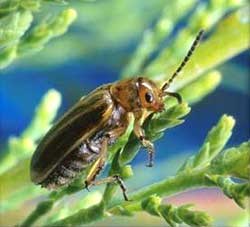
NPS photo: Glen Canyon NRA Tamarisk Leaf Beetles After years of controlled studies, researchers released the northern tamarisk leaf beetle in a number of locations throughout the west in 2001. As a biological control agent for non-native tamarisk trees, tamarisk leaf beetles and their larvae feed exclusively on tamarisk foliage. The larvae induce the most damage by completely defoliating the trees. 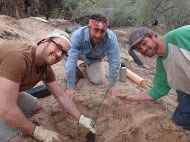
The potential for widespread tamarisk mortality along the Colorado River in Grand Canyon National Park has unknown impacts to the riparian ecosystem, as well as to visitor experience. Tamarisk trees currently provide habitat for a variety of wildlife species as well as shade and tie-off points for boaters. 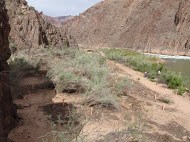
Archeological Site Excavation This work is funded via Grand Canyon Association by a grant from the Nina Mason Pulliam Charitable Trust and by National Park Service Concession Franchise Fees. For more information, contact Deanna Greco, Physical Sciences Program Manager, at 928-638-7817 or Melissa McMaster, Plant Biologist , at 928-638-7465 |
Last updated: February 24, 2015
